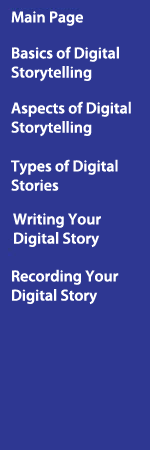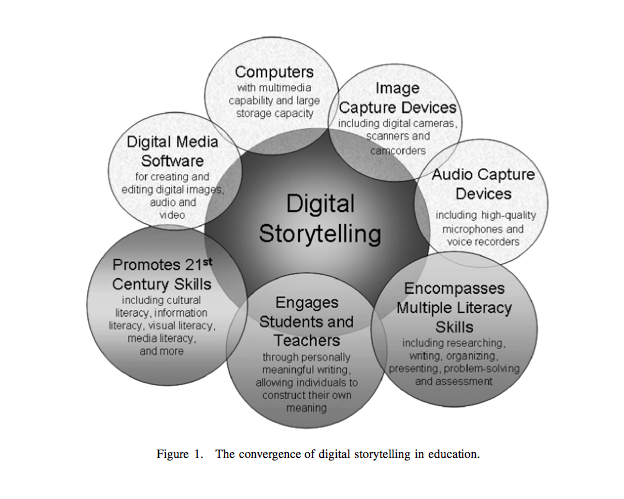


Content by Maggie Burch
Converted for the web by Amanda Haislip and Athena Hensel
(printable version here)
What is a digital story?
The Center for Digital Storytelling defines a digital story as "A short, first person video-narrative created by combining recorded voice, still and moving images, and music or other sounds."
"At its core, digital storytelling allows computer users to become creative storytellers through the traditional processes of selecting a topic, conducting some research, writing a script, and developing an interesting story" (Robin 222).
At the University of Richmond, teachers who assign digital stories to their students typically arrange a how-to, demonstration day through the Technology Learning Center (TLC). The TLC has all of the resources students need to create a digital story, from cameras, microphone/headphones, computers with the appropriate movie-making software, and knowledgable staff who can help you with every step.
Students upload their videos to YouTube, and share the links with their teacher and/or classmates. The TLC also recommends keeping your script in a Google Doc, and linking the script from your YouTube page. The TLC and its staff are certainly masters of the technology side of creating digital stories. However, the core of a digital story is the words being read along with the video. Because of the importance of the script, this page is dedicated to helping you write your script for your digital story. The Writing Center and Writer's Web already have numerous resources to help students write many types of papers and assignments, but the digital story script requires a specific type of writing, which is why this page of Writing in the Disciplines is being added.

Why make a digital story?
A digital story can be an extremely effective means of presenting a narrative that emotionally grabs the audience; it can also provide an immense amount of information on a topic in a shorter amount of time by combining the words and sounds the audience hears and the pictures they see.
The skills that students master from the creation of digital stories are a combination of:
- Digital Literacy
- Global Literacy
- Technology Literacy
- Visual Literacy
- Information Literacy
Consider how Dr. Joe Essid's student, Carly, employed several technologies to make her story, "Transhumanism," for a First-Year Seminar on the History of Cyberspace. She replied to Ray Kurzweil's idea of The Singularity, a merger of human intelligence with cybernetic systems. To show the degradation of life for people after this event, Carly used voice-morphing to make her voice more mechanical, then paired the narrative with eerie still photos from advertising campaigns and science-fictional artwork
Carly's subtitles add some very moody elements to the piece, and help the viewer who might otherwise have trouble with the morphed voice. The line "I don't know what a real voice sounds like" has great effect and only uses a few words.
For more information, check out the other Writer's Web pages onWriting Online
Writer's Web | Writing Center | Make an Appointment | Library | Copyright Info
Document/Image Cited: Robin, Bernard. "Digital Storytelling: A Powerful Technology Tool for the 21st Century Classroom." Theory Into Practice 47.3 (2008): 220-28. Taylor and Francis Online. Web. 26 October 2012.